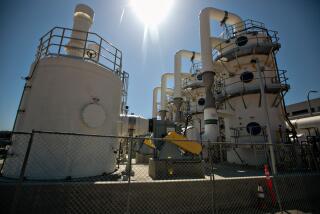Sky-high bacteria could affect climate, scientists say
- Share via
A team of storm-chasing scientists sampling rarefied air has found a world of bacteria and fungi floating about 30,000 feet above Earth. The findings, detailed Monday in the Proceedings of the National Academy of Sciences, suggest that microbes have the potential to affect the weather.
Scientists have long studied airborne bacteria, but they typically do so from the ground, often trekking to mountain peaks to examine microbes in fresh snow. Beyond that, they don’t know much about the number and diversity of floating microbes, said study coauthor Athanasios Nenes, an atmospheric scientist at Georgia Tech.
To get a glimpse of this hovering world, Nenes and his colleagues hitched several rides on a NASA aircraft as onboard instruments sampled the air before, during and after hurricanes Earl and Karl in 2010. The plane flew into the upper troposphere, about 6 miles above the surface.
During nine flights — most over the Caribbean and the midwest Atlantic — the researchers ran the outside air over a series of filters, each time capturing material from an average of 212 cubic feet of ambient air. They sampled a variety of environments, from the cloudy masses that preceded Hurricane Earl to the cloud-free air after Hurricane Karl passed.
The researchers focused on a ribosomal RNA gene called SSU rRNA, which can reliably identify bacterial species. They calculated that there were about 144 bacterial cells per cubic foot of air.
The bacteria accounted for 20% of the particles in their size range — stuff that scientists had assumed was just sea salt and dust.
“We were surprised,” Nenes said.
The filters picked up fungi too, though in concentrations that were at most only 10% as high as for the bacteria.
The microbial populations were very different before and after a storm, Nenes said; that makes sense, given that hurricanes have the potential to kick a fresh batch of bugs into the air.
Among other types, the scientists found Escherichia and Streptococcus bacteria in their samples — microbes typically associated with human and animal feces that could have been thrown into the air as the storms swept through populated areas.
The researchers identified 17 types of bacteria that were found in all the samples, leading the team to suspect that those organisms constituted a core microbiome for the lower atmosphere. These bacteria must have developed traits that allowed them to bear freezing temperatures, feed on the scarce carbon compounds in cloud dust and survive in an environment bombarded by ultraviolet radiation.
Other studies have revealed the presence of plant-based microbes that are thought to induce freezing in order to damage leaves and then infect them.
Microbes with this freezing ability could conceivably collect water vapor and seed clouds, causing them to release rain. It could very well represent a way of transporting microbes across continents, Nenes said.
That possibility also has implications for the ways in which illnesses spread, he added.
“Once you get to that altitude, if you can survive, you can basically circulate the Earth very quickly,” Nenes said. “You can start out in Europe and end up in Asia.”
The finding could be exciting for astrobiologists, who wonder about the extreme environments in which bacteria can live on Earth — and whether they could do so on other planets as well.
“It definitely lends to the idea that life is pretty resilient and you can adapt to almost any environment if you have a bare minimum of sustenance,” Nenes said.
The paper provides a fascinating preliminary census of the airborne microbes, said David Sands, a bacteriologist at Montana State University who was not involved in the study.
But such research has a long way to go before proving that microbes in the atmosphere are doing anything other than waiting for their slow fall back to Earth, he added.
“If they go up, they want to get back down,” Sands said.







